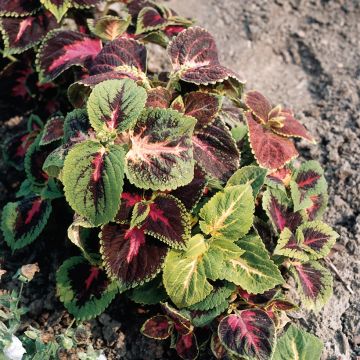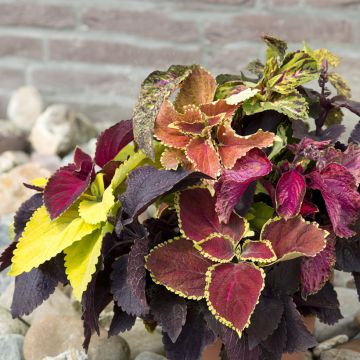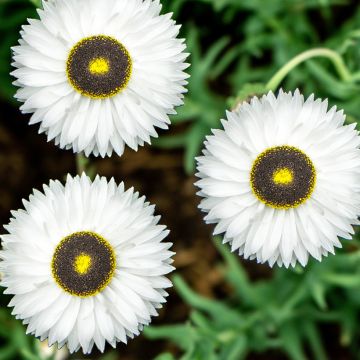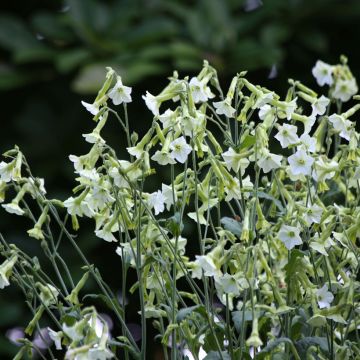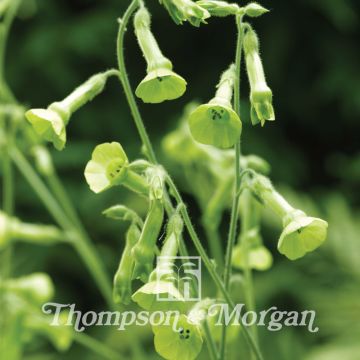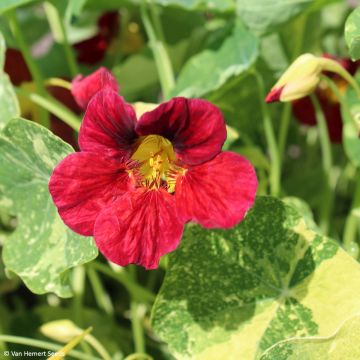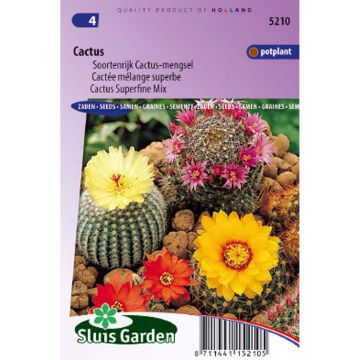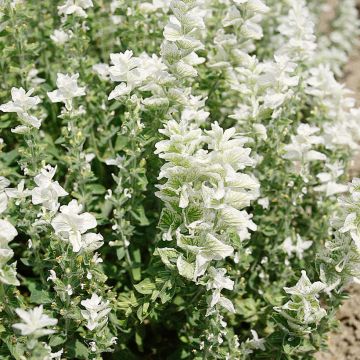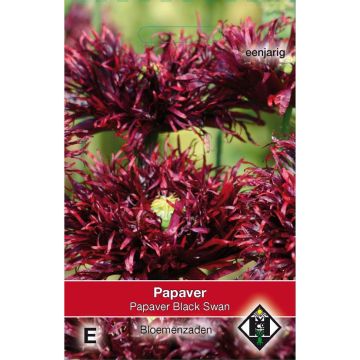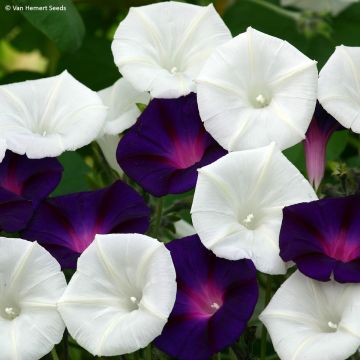

Graines de Coléus Kong en mélange - Solenostemon scutellaroides
Solenostemon Kong Mix
Solenostemon scutellaroides Kong Mix
Coleus
This item cannot be shipped to the selected country
Dispatch by letter from €3.90
More information
Schedule delivery date,
and select date in basket
This plant carries a 6 months recovery warranty
More information
We guarantee the quality of our plants for a full growing cycle, and will replace at our expense any plant that fails to recover under normal climatic and planting conditions.
Seed-only orders are dispatched by sealed envelope. The delivery charge for seed-only orders is €3.90.
Does this plant fit my garden?
Set up your Plantfit profile →
Description
The plants of Coleus 'Kong' stand out for the size of their leaves, which are larger and therefore more spectacular than those of other varieties. They are richly variegated with vibrant and shimmering shades, highly variable depending on the varieties that make up this mix. These non-hardy perennial plants are grown as indoor plants or in the garden as particularly ornamental annual plants. Sowing them is easy and their cultivation presents no difficulties in a sunny but not scorching position or in partial shade, in soil that remains moist.
Coleus, also known as Solenostemon or Plectranthus, are plants related to nettles and basil. They belong to the mint family, as indicated by their small bilabiate flowers with elongated lower lip, their fleshy square-sectioned stems, and their toothed and velvety leaves on the underside. This genus includes around sixty species of tender shrubby perennials, native to Asia and tropical Africa. Horticulture has given rise to numerous hybrids, among which are those of the 'Kong' series, selected for their highly developed foliage and ease of cultivation.
Coleus 'Kong' form rounded clumps, not exceeding 45 cm (18in) in height and 40 cm (16in) in diameter in one season. They have mixed variegated foliage. Among the colours, there are different shades of green, red, pink to purple, brick, and cream. Each variety redistributes the play of colours in a different way. All these hues are enhanced by the velvety texture of the large leaves. The flowering, fairly discreet, takes place in summer, in the form of small flowers in different shades of blue, white, or pink. It is often recommended to remove these flowers so that the plants do not exhaust themselves producing seeds and maintain a generous foliage.
Coleus, sometimes called 'painted nettle' because of their incredibly diverse foliage, are irreplaceable for bringing a beautiful exotic touch to any planting... in the garden as well as in the house, where they will live for several years. They appreciate a partially shaded position, which can be found on the edge of a bed of tall perennials or shrubs, or in a shady rockery, exposed to the north or east, away from the scorching rays of the sun. They can be used to create small mosaic-like flower beds and pair well with begonias in flower pots. The richness of their colours makes them somewhat difficult to associate: small ferns like Polypodium, Dichondra repens Silver Falls, or purple wandering jew (Tradescantia pallida) will be good companions for the Coleus Kong .
Report an error about the product description
Flowering
Foliage
Plant habit
Botanical data
Solenostemon
scutellaroides
Kong Mix
Lamiaceae
Coleus
Cultivar or hybrid
Other Coleus seeds
Planting and care
You can sow Coleus all year round. Use good quality soil, possibly enriched with well decomposed compost. Lightly press down the surface of the sowing tray before sowing your seeds on the surface. Do not cover the seeds with soil. Water lightly. Place your tray in the light, at a temperature of 20 to 25°C. The use of a mini greenhouse can speed up seed germination.
The seeds will germinate in 10 to 20 days. As soon as the plants have reached a sufficient height to be handled, transplant them into 7cm (3in) pots. Then into their final pot with a diameter of 15cm (6in).
For plants that will be planted outdoors, start gradually acclimating them to a temperature of 15°C, 15 days before their final planting. By the end of May or early June, the temperature will be warm enough in the garden to plant your young plants. Choose a sunny location. Add a good shovelful of compost to each planting hole. Space your plants 25 to 30cm (10 to 12in) apart.
Remove flower spikes as soon as they form to prevent the plant from expending energy prematurely.
Sowing period
Intended location
This item has not been reviewed yet - be the first to leave a review about it.
Flower seeds
Haven't found what you were looking for?
Hardiness is the lowest winter temperature a plant can endure without suffering serious damage or even dying. However, hardiness is affected by location (a sheltered area, such as a patio), protection (winter cover) and soil type (hardiness is improved by well-drained soil).

Photo Sharing Terms & Conditions
In order to encourage gardeners to interact and share their experiences, Promesse de fleurs offers various media enabling content to be uploaded onto its Site - in particular via the ‘Photo sharing’ module.
The User agrees to refrain from:
- Posting any content that is illegal, prejudicial, insulting, racist, inciteful to hatred, revisionist, contrary to public decency, that infringes on privacy or on the privacy rights of third parties, in particular the publicity rights of persons and goods, intellectual property rights, or the right to privacy.
- Submitting content on behalf of a third party;
- Impersonate the identity of a third party and/or publish any personal information about a third party;
In general, the User undertakes to refrain from any unethical behaviour.
All Content (in particular text, comments, files, images, photos, videos, creative works, etc.), which may be subject to property or intellectual property rights, image or other private rights, shall remain the property of the User, subject to the limited rights granted by the terms of the licence granted by Promesse de fleurs as stated below. Users are at liberty to publish or not to publish such Content on the Site, notably via the ‘Photo Sharing’ facility, and accept that this Content shall be made public and freely accessible, notably on the Internet.
Users further acknowledge, undertake to have ,and guarantee that they hold all necessary rights and permissions to publish such material on the Site, in particular with regard to the legislation in force pertaining to any privacy, property, intellectual property, image, or contractual rights, or rights of any other nature. By publishing such Content on the Site, Users acknowledge accepting full liability as publishers of the Content within the meaning of the law, and grant Promesse de fleurs, free of charge, an inclusive, worldwide licence for the said Content for the entire duration of its publication, including all reproduction, representation, up/downloading, displaying, performing, transmission, and storage rights.
Users also grant permission for their name to be linked to the Content and accept that this link may not always be made available.
By engaging in posting material, Users consent to their Content becoming automatically accessible on the Internet, in particular on other sites and/or blogs and/or web pages of the Promesse de fleurs site, including in particular social pages and the Promesse de fleurs catalogue.
Users may secure the removal of entrusted content free of charge by issuing a simple request via our contact form.
The flowering period indicated on our website applies to countries and regions located in USDA zone 8 (France, the United Kingdom, Ireland, the Netherlands, etc.)
It will vary according to where you live:
- In zones 9 to 10 (Italy, Spain, Greece, etc.), flowering will occur about 2 to 4 weeks earlier.
- In zones 6 to 7 (Germany, Poland, Slovenia, and lower mountainous regions), flowering will be delayed by 2 to 3 weeks.
- In zone 5 (Central Europe, Scandinavia), blooming will be delayed by 3 to 5 weeks.
In temperate climates, pruning of spring-flowering shrubs (forsythia, spireas, etc.) should be done just after flowering.
Pruning of summer-flowering shrubs (Indian Lilac, Perovskia, etc.) can be done in winter or spring.
In cold regions as well as with frost-sensitive plants, avoid pruning too early when severe frosts may still occur.
The planting period indicated on our website applies to countries and regions located in USDA zone 8 (France, United Kingdom, Ireland, Netherlands).
It will vary according to where you live:
- In Mediterranean zones (Marseille, Madrid, Milan, etc.), autumn and winter are the best planting periods.
- In continental zones (Strasbourg, Munich, Vienna, etc.), delay planting by 2 to 3 weeks in spring and bring it forward by 2 to 4 weeks in autumn.
- In mountainous regions (the Alps, Pyrenees, Carpathians, etc.), it is best to plant in late spring (May-June) or late summer (August-September).
The harvesting period indicated on our website applies to countries and regions in USDA zone 8 (France, England, Ireland, the Netherlands).
In colder areas (Scandinavia, Poland, Austria...) fruit and vegetable harvests are likely to be delayed by 3-4 weeks.
In warmer areas (Italy, Spain, Greece, etc.), harvesting will probably take place earlier, depending on weather conditions.
The sowing periods indicated on our website apply to countries and regions within USDA Zone 8 (France, UK, Ireland, Netherlands).
In colder areas (Scandinavia, Poland, Austria...), delay any outdoor sowing by 3-4 weeks, or sow under glass.
In warmer climes (Italy, Spain, Greece, etc.), bring outdoor sowing forward by a few weeks.





































